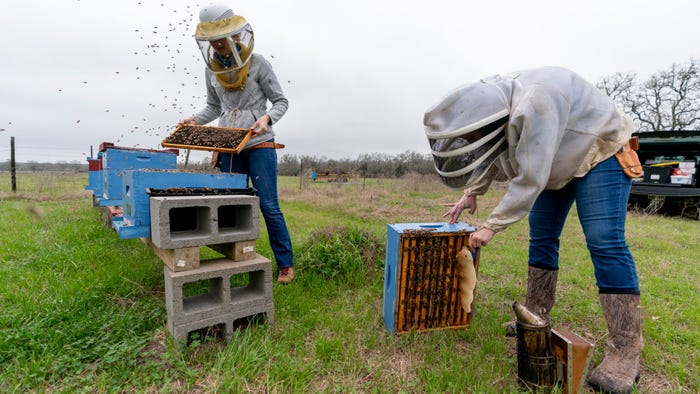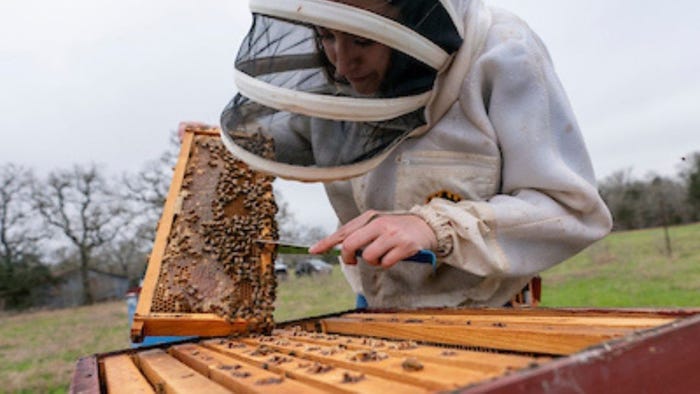May 23, 2023

While Texas bee populations have declined due to drought and other harsh weather conditions over recent years, they seem to be in good shape for a late spring and early summer recovery, said Texas A&M AgriLife entomologists.
“There was a 14% drop in honey production in 2021, and while there’s no data about 2022 as yet, one can assume production was affected for a couple of reasons,” said Molly Keck, Texas A&M AgriLife Extension Service entomologist for Bexar County. “The two main reasons were that there was not enough forage in some areas of the state due to drought as well as the fact that honeybees don’t go out and forage when temperatures are too high.”
Keck said lack of foraging and nectar-producing resources means less food brought back into the hive to be turned into honey.

Because small-scale beekeeper operations are mostly stationary, they are at the mercy of local weather conditions. (Texas A&M AgriLife photo by Laura McKenzie)
“Areas where there are abundant nectar and pollen sources, along with other good conditions, are where honeybees will do best,” she said.
Keck said while honey production is important, the most vital aspect of having adequate bee populations is their role as pollinators, particularly for agricultural crops.
Bees have taken a beating
Texas Beekeepers Association President Dodie Stillman said Texas beekeepers were faced with “Snowmageddon,” a term applied to Winter Storm Uri in early 2021, which brought freezing temperatures, ice and snow for about three weeks.
The Bee Informed Partnership's colony loss report showed Texas had an annual loss of 33.9% in honeybee population from April 2021 to April 2022. And Texas beekeeper quarterly data for April to June 2022 showed honeybee colony losses much higher than the acceptable loss of 13% to 17%. Additionally, a U.S. Department of Agriculture report on honeybee colonies nationwide found that from April to June of 2022, 45.2% of colonies were affected by varroa mites.
“Small-scale beekeepers lost a significant number of bees during the past few years, and it has taken a while for them to come back,” Stillman said. “Small-scale beekeepers are mostly stationary, so if the local weather is harsh or doesn’t allow for the production of nectar-bearing flowers, bees will produce less honey.”
Fortunately, Stillman said, beekeepers in Texas and elsewhere regularly split their bee colonies to create more of them, which has helped in the overall recovery.
Juliana Rangel, Texas A&M AgriLife Research honeybee scientist in the Department of Entomology, Bryan-College Station, said the extended winter snows in 2021 were followed by extensive drought throughout the state last year, further exacerbating losses.
“Even earlier this year, we had some strange winter-spring weather that was unusually wet, which kept many colonies in this part of our state inactive or unable to forage,” Rangel said.
Reason to bee optimistic
Stillman said while beekeepers are always worried about the weather, things are already looking positive for 2023.
“If the bee populations get sufficient rain at the right times – and not too much to make the nectar fall out of flowers – they should be in much better shape this year than in previous years,” she said.
Rangel said it’s very possible that by late spring or early summer, there could be a significant increase in bee populations and activity — if milder weather prevails.
“We are already seeing a proliferation of the types of wildflowers bees prefer for gathering their nectar,” she said.

Texas honey bee populations seem to be bouncing back after a variety of environmental challenges over the past few years. (Texas A&M AgriLife photo by Laura McKenzie)
Some of the wildflowers bees prefer include horse mint, Indian paintbrush and almond verbena.
Rangel also said the number of bee colonies in the U.S. has been edging upward by about 1% annually, and that trend applies to Texas colonies as well.
“If you combine that increase with the amount of floriation and good local weather patterns, we may get a good flow and see a spike in nectar production in late spring and summer,” she said.
About honey production
Rangel said Texas typically ranks sixth among states for honey production – after North and South Dakota, California, Florida and Minnesota.
The recent rains have brought a massive floriation that has the potential to greatly boost bee populations and honey production later this spring and early summer.
“Bee populations in Central Texas are growing, and some bees are already in ‘honey flow,’ which means they are bringing back enough nectar to store and feed to their young,” Stillman said.
Steven Klose, professor and AgriLife Extension economist in Texas A&M’s Department of Agricultural Economics, said a challenge for small-scale beekeepers is the business of competing in a market where honey is produced on a large scale and readily available.
“Similar to other commodity product markets, small-scale honey producers may struggle to compete from a cost-efficiency standpoint,” Klose said. “Therefore, they need to find a way to differentiate their product to attract a premium price. Niche market opportunities may come from simply being ‘locally sourced’ or being produced from a unique nectar source.”
Bees in agriculture
Along with their role in honey production, bees are responsible for pollinating 75% of the world’s flowering plants and 35% of the world’s crops. In particular, honeybees are the most common pollinator and an important bee to domestic agriculture.
It is estimated that the honeybee’s annual contribution to the U.S. economy is at least $15 billion. More than 90 different crops—about one-third of total crop production in the U.S.—depend on bees for their survival.
Bees also pollinate crops that feed cattle, such as clover and alfalfa, making them very important to both the beef cattle and dairy industries.
“Texas is one of the preferred states for many commercial pollinators who hold bees here in winter and then take them to other states for pollination services as early as February and throughout the year,” Rangel said.
Source: Texas A&M AgriLife Extension, AgriLife Today
About the Author(s)
You May Also Like




